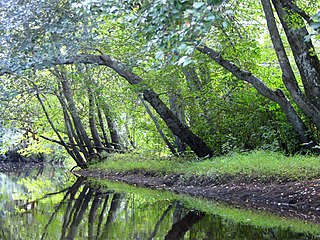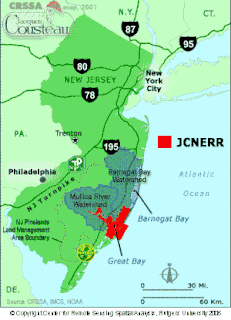Turtle Creek is a 1.9-mile-long (3.1 km) [1] tributary of the Mullica River in southern New Jersey in the United States. [2]

A tributary or affluent is a stream or river that flows into a larger stream or main stem river or a lake. A tributary does not flow directly into a sea or ocean. Tributaries and the main stem river drain the surrounding drainage basin of its surface water and groundwater, leading the water out into an ocean.

The Mullica River is a 50.6-mile-long (81.4 km) river in southern New Jersey in the United States. The Mullica was once known as the Little Egg Harbor River.

New Jersey is a state in the Mid-Atlantic region of the Northeastern United States. It is a peninsula, bordered on the north and east by the state of New York, particularly along the extent of the length of New York City on its western edge; on the east, southeast, and south by the Atlantic Ocean; on the west by the Delaware River and Pennsylvania; and on the southwest by the Delaware Bay and Delaware. New Jersey is the fourth-smallest state by area but the 11th-most populous, with 9 million residents as of 2017, and the most densely populated of the 50 U.S. states; its biggest city is Newark. New Jersey lies completely within the combined statistical areas of New York City and Philadelphia and was the second-wealthiest U.S. state by median household income as of 2017.
From source to outlet, it is entirely surrounded by the tidal marshes of the Swan Bay Wildlife Management Area. The former upper reaches of the stream, reaching some distance north into the Wharton State Forest, have been diverted and given their own channel, reaching the Mullica to the west of the remaining stream.

Wharton State Forest is the largest state forest in the U.S. state of New Jersey. It is the largest single tract of land in the state park system of New Jersey, encompassing approximately 122,880 acres (497.3 km2) of the Pinelands northeast of Hammonton. It is protected acreage is divided between Burlington, Camden, and Atlantic counties. The entire forest is located within Atlantic coastal pine barrens ecoregion as well as the New Jersey Pinelands National Reserve. The forest is located in the forested watershed of the Mullica River, which drains the central Pinelands region into the Great Bay. The forest is under the jurisdiction of the New Jersey Division of Parks and Forestry.





